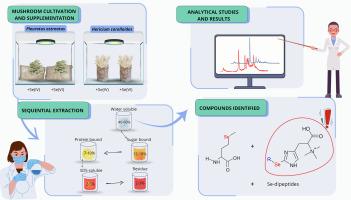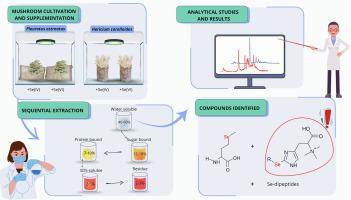食用菌产硒新化合物的鉴定
IF 9.8
1区 农林科学
Q1 CHEMISTRY, APPLIED
引用次数: 0
摘要
研究了在亚硒酸盐(Se(IV))和硒酸盐(Se(VI))存在下生长的两种常见食用菌平菇(Pleurotus ostreatus)和Hericium coralloides)对硒的代谢能力。以硒(IV)为硒源时,硒的吸收效率提高4 ~ 8倍。阴离子交换HPLC-ICP-MS显示Se(IV)完全(>98.5 %)代谢为有机形式,而未代谢的Se(VI)达到8-18 %,具体取决于物种。代谢的硒主要以水溶性的形式被回收(>40 %),其次是水不溶性多糖的~20 %和水不溶性蛋白质的 ~ 10 %。硒代蛋氨酸是P. ostreatus中含量最多的物种,占吸收硒的45% %以上,而H. coralloides的含量则少得多(15 - 18% %)。水溶性硒代谢组占样品中硒的40-60 %,通过ESI-MS的HILIC表征,发现了另外10种代谢物的存在。其中包括几种硒氨酸衍生物和含硒半胱氨酸的乙烯基二肽,提示以前未报道的蘑菇硒代谢途径。本文章由计算机程序翻译,如有差异,请以英文原文为准。


Identification of new selenium compounds produced by edible mushrooms
The ability of two common edible mushroom species, Pleurotus ostreatus and Hericium coralloides, to metabolize selenium when grown in the presence of selenite (Se(IV)) and selenate (Se(VI)) was investigated. The efficiency of selenium absorption was 4–8 times higher when Se(IV) was used as selenium source. Anion-exchange HPLC-ICP-MS showed complete (>98.5 %) metabolization of Se(IV) to organic forms, while non-metabolized Se(VI) reached 8–18 %, depending on the species. Metabolized selenium was principally (>40 %) recovered as water-soluble species, followed by ∼20 % in water-insoluble polysaccharides and ∼ 10 % in water-insoluble proteins. Selenomethionine was the most abundant species in P. ostreatus, accounting for over 45 % of absorbed selenium and much less abundant (15–18 %) in H. coralloides.
The water-soluble selenometabolome, accounting for 40–60 % of selenium in the samples, was characterized by HILIC with ESI-MS, revealing the presence of ten additional metabolites. These included several selenoneine derivatives and vinyl-selenocysteine-containing dipeptides, suggesting previously unreported pathways for selenium metabolism in mushrooms.
求助全文
通过发布文献求助,成功后即可免费获取论文全文。
去求助
来源期刊

Food Chemistry
工程技术-食品科技
CiteScore
16.30
自引率
10.20%
发文量
3130
审稿时长
122 days
期刊介绍:
Food Chemistry publishes original research papers dealing with the advancement of the chemistry and biochemistry of foods or the analytical methods/ approach used. All papers should focus on the novelty of the research carried out.
 求助内容:
求助内容: 应助结果提醒方式:
应助结果提醒方式:


